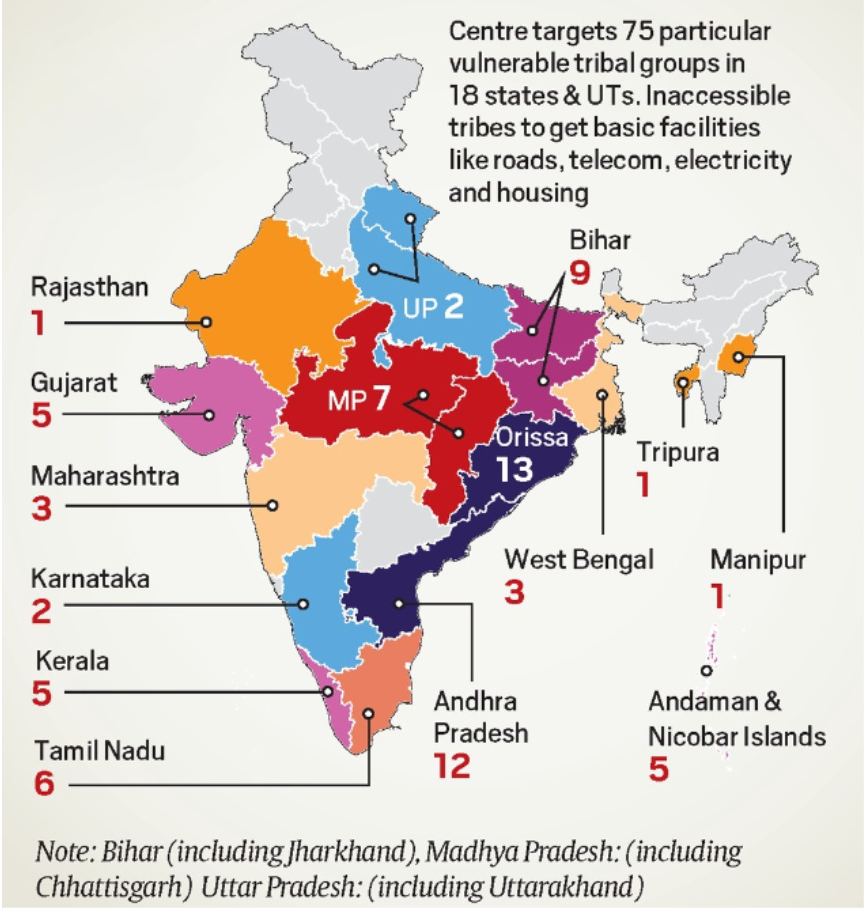Important Facts For Prelims
Status of Adivasi Livelihoods (SAL) Report, 2022
- 17 Jan 2024
- 5 min read
Why in News?
Recently, a report Status of Adivasi Livelihoods (SAL) Report, 2022, released by the non-profit organization PRADAN highlights that Food subsidy through Public Distribution System (PDS) has reduced the stress that Adivasi households would have faced due to lower income.
- The aim of this report is to understand the status of livelihoods of Scheduled Tribes from India’s central belt.
What are the Key Highlights of the Report?
- The SAL Report, 2022 is based on a household survey covering a sample of 6,019 households.
- The report revealed that the average annual income for Adivasi households in Madhya Pradesh and in Chhattisgarh is much less than the national average annual income per agricultural household during the agricultural year 2018-19.
- In Chhattisgarh, the food and other items consumed by an Adivasi household in a year have a market price of almost Rs 18,000.
- Only around 13% of this amount is spent by households to procure those goods. The remaining 87% of the amount, is the subsidy given by the government.
- An Adivasi household in Madhya Pradesh procures goods from PDS worth Rs 10,000 market price annually, spending only 22% of the amount to procure them.
- In Madhya Pradesh, 32% of Adivasi households, 27 % of non-Adivasi households, and 61% of Particularly Vulnerable Tribal Groups (PVTGs) households reported being severely food insecure.
- In Chhattisgarh, 27% of Adivasi households, 42% of non-Adivasi households, and 29% of PVTG households reported being severely food insecure.
- The areas of Madhya Pradesh’s west, dominated by the Bhil community (which overlaps into neighboring Rajasthan, Gujarat and Maharashtra), had the highest average household income among both Adivasi and non-Adivasi households.
- It was 1.5 times higher than other regions of the state.
- Adivasi women enjoy more autonomy than their non-Adivasi counterparts. But the workload of doing household chores and livelihood activities is mostly borne by Adivasi women.
- Gender discrimination remains alive in decision-making practices and also customary practices.
Who are the Bhil Tribes?
- The Bhil are one of the largest tribal groups, living in Chhattisgarh, Gujarat, Karnataka, Madhya Pradesh, Maharashtra, Andhra Pradesh and Rajasthan.
- The name is derived from the word ‘billu’, which means bow.
- The Bhil are known to be excellent archers coupled with deep knowledge about their local geography.
- Traditionally, experts in guerrilla warfare, most of them today are farmers and agricultural laborers. They are also skilled sculptors.
Who are Particularly Vulnerable Tribal Groups (PVTGs)
- PVTGs are more vulnerable among the tribal groups. Due to this factor, more developed and assertive tribal groups take a major chunk of the tribal development funds because of which PVTGs need more funds directed for their development.
- In 1973, the Dhebar Commission created Primitive Tribal Groups (PTGs) as a separate category, which are less developed among the tribal groups. In 2006, the Government of India renamed the PTGs as PVTGs.
- In this context, in 1975, the Government of India initiated to identify the most vulnerable tribal groups as a separate category called PVTGs and declared 52 such groups, while in 1993 an additional 23 groups were added to the category, making it a total of 75 PVTGs out of 705 Scheduled Tribes.
- Among the 75 listed PVTG’s the highest number are found in Odisha.
UPSC Civil Services Examination Previous Year Question (PYQ)
Prelims
Q. Consider the following statements about Particularly Vulnerable Tribal Groups (PVTGs) in India: (2019)
- PVTGs reside in 18 States and one Union Territory.
- A stagnant or declining population is one of the criteria for determining PVTG status.
- There are 95 PVTGs officially notified in the country so far.
- Irular and Konda Reddi tribes are included in the list of PVTGs
Which of the statements given above are correct?
(a) 1, 2 and 3
(b) 2, 3 and 4
(c) 1, 2 and 4
(d) 1, 3 and 4
Ans: C





